
1) What do you make of the extension of the comment period for federal agencies to Keystone XL?
President Obama said he would take his time to make a considered decision whether or not to approve the Keystone XL pipeline, and that appears to be exactly what he's doing.
Any day without the Keystone XL pipeline is a good day, because it means more dirty tar sands crude oil stays in the ground where it belongs. The president said that he would not approve Keystone XL if it contributed significantly to climate disruption, and it is certain that it will.
2) The State Department wrote in a recent report that even if the pipeline isn’t built, the oil will still be exported by other means. So, is protesting the pipeline fruitless?
Not at all. The State Department’s flawed assessment made the assumption that the tar sands will come out of the ground, whether the Keystone XL is built or not, which is not at all certain. What’s more, there are several tar sands pipelines proposed to the West of Alberta through British Columbia and to the East. None have been approved, and all have faced significant delays, as well as growing public opposition. Many Canadians feel the same way that Americans do -- they don’t want toxic, corrosive tar sands threatening their land and water.
3) For many, the debate on Keystone comes down to jobs. The presence of a pipeline will provide jobs to an economy that desperately needs them. How do you answer that?
The president himself has said that the tar sands pipeline is not a major jobs creator. But there’s no question that we need jobs. Fortunately, job growth in the clean energy economy is more than two times faster than the rest of the economy. Every dollar invested in clean energy creates three times as many jobs as every dollar invested in fossil fuel.
A recent study conducted by nonpartisan business group Environmental Entrepreneurs (E2) found that more than 78,600 clean energy and clean transportation jobs were created in 2013. Solar power generation saw the most growth in 2013, with more than 21,600 jobs added.
4) Has President Obama done enough to curb climate change?
I would give the president an “incomplete” on his efforts to fight the climate crisis. There is no doubt that President Obama has taken strong action to combat climate disruption through historic fuel efficiency standards for vehicles and his support for growing clean energy sources. The Sierra Club is very supportive of the Obama administration’s Climate Action Plan, which will take the first steps ever to clean up carbon pollution from dirty power plants this summer. However, the president still has more than two years to solidify his climate legacy by protecting American landscapes from destructive mining and fracking, rejecting dangerous drilling in the Arctic, and saying no to the expansion of dirty fossil fuels like tar sands.
5) Most Americans show a low level of concern about Global Warming. How do you make climate change top of mind in political debates in this country?
That’s not the case at all. There is strong bipartisan support among Americans for government policies that will combat climate disruption. According to recent national polling, majorities of Democrats and Republicans support the following policies: "funding more research into renewable energy sources" (84% of Democrats and 60% of Republicans support this), "regulating carbon dioxide as a pollutant" (85% and 55% respectively), and "eliminating all subsidies for the fossil-fuel industry" (67% and 52%).
An important group of voters care deeply about climate action. Younger voters understand the threat posed by climate disruption and want to see strong action by their elected leaders to address the threat. Nearly two-thirds of voters aged 18 to 34 who voted in the 2012 general election (65%) say that "climate change" is already affecting them or will in their lifetimes.
Young voters' recognition of the threat posed by climate disruption translates into strong support for action by President Obama to address it. Overall, 80% of young voters support the President taking action to "address climate change." Young voters say they are more likely to support candidates who back President Obama's climate plan and less likely to support those who don't.
6) You wrote an op-ed piece for Huffington Post on Tuesday. In part, you wrote, “There's no shortage of good news about renewable energy -- I see something exciting practically every day -- and each new development is another reason for optimism.” What are you most optimistic about right now when it comes to America’s renewable energy future?
That the clean energy victories we are seeing each day are irreversible. We’re on a one-way trip, and once we leave fossil fuels behind, we’re never going back. Ten years ago, none of the so-called experts predicted clean energy would be this competitive this soon. They didn’t predict solar panels would drop so quickly in price, or that solar capacity would grow by 400 percent in the past 4 years.
7) You recently criticized the Supreme Court’s decision to strike down campaign contribution limits. You said, in part, that big polluters are now “allowed to dump millions more of their corrupt dollars into politics.” Some might argue that your group is no better. How would you respond?
First, it’s laughable to say that the Sierra Club is as well-funded as the big polluters who are flooding our political system with dirty money. Our greatest strength lies in our 2.4 million members and supporters who stand together to fight for clean air, clean water, and a clean government that works for the American people. The Sierra Club is involved in campaign finance reform efforts to get corrupt money out of politics. We are playing by the rules as they are currently written, and we aren’t going to bring a pillow to a knife fight with the Koch Brothers.
8) Earth Day was this week. What cities do you see making an effort towards “green” initiatives, and where do you see localities that need to work on this?
It would be hard to pick the top American cities that are doing their part to combat climate disruption. Across the country, states, cities, and towns are embracing commonsense solutions to save families money and create jobs. According to E2, the top 10 states for clean energy and transportation job growth in 2013 were Texas, Hawaii, Maryland, Massachusetts, Illinois, Nevada, Oregon, New York, Missouri, and California.
One example is that last year, the Sierra Club stood up with then-Los Angeles Mayor Antonio Villaraigosa to commit to moving Los Angeles beyond coal by 2025, making Los Angeles the nation’s largest city to go coal free.
9) What do you view as the single biggest change that needs to be made to further combat climate change?
We have to end our reliance on fossil fuels. A recent, sobering report from the Intergovernmental Panel on Climate Change found that much of the planet’s known and economically recoverable supply of fossil fuels will need to be left in the ground to avoid catastrophic climate disruption. We have to act now to decrease our reliance on fossil fuels through technology and better efficiency, while hastening the transition to clean energy like wind and solar.
10) Ultimately, given the landscape now, how will the president decide on Keystone XL?
Tar sands are 20 percent more carbon intensive than conventional oil. They are more corrosive than conventional crude, making them more dangerous to transport. And they are nearly impossible to clean up in the event of a spill. Tar sands are the dirtiest oil in the world. This project would put millions of Americans’ drinking water and safety at risk, while running counter to the president’s own goals for climate action. With those facts, I believe the president has all the evidence he needs to reject the Keystone XL tar sands pipeline.
